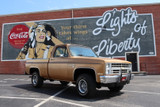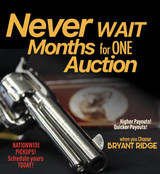Best of The West
Best of The West
Bryant Ridge's Analysis
*This example is a variant of the Marlin Model 1894 that features a cross-bolt safety*
The Marlin 1894 was originally patented on August 1, 1893 by L.L. Hepburn. With this design, Marlin simplified and strengthened the internal lever-action mechanism while continuing the practice of using a flat solid steel top receiver with side ejection. With the Model 1894, Marlin removed the rear-locking lug, which extended down into the trigger guard and had a tendency to pinch the shooter’s fingers during rapid-fire cycling. Other design improvements over the Model 1889 included a one-piece trigger and a two-piece firing pin to prevent the rifle from firing unless the finger lever was fully closed or if the locking lug were missing. Additionally, the finger lever lock of the Model 1889 was eliminated on the Model 1894 and replaced by a latch built into the lever itself. This model was chambered in the same calibers with the addition of the .25/20 and later .218 Bee. The Model 1894 and its successors found particular favor in Canada, Alaska, and the Pacific Northwest, where precipitation combined with cold temperatures sometimes caused top-eject designs to freeze solid. During the Klondike Gold Rush, the solid-top Marlin design was preferred by many prospectors facing subzero temperatures and dangerous animals, since the solid top frame was better at keeping freezing rain, snow and dirt out of the operating parts of the action. With the popularity of magnum revolver cartridges in the 1960s, in 1969, Marlin produced a short-action Model 1894 that was designed for modern high-pressure .44 Magnum cartridges. Marlin had briefly manufactured its Model 336 chambered for the .44 magnum cartridge. However, after a few years of development, Marlin reintroduced the model 1894.
Images


Bryant Ridge's Analysis
The Ruger Single-Six is a single-action rimfire revolver manufactured by Sturm, Ruger & Co. First introduced in June 1953, the Single-Six is currently produced as the New Model Single-Six, which features Ruger's transfer bar mechanism for increased safety. This mechanism allows you to carry the revolver safely with all six chambers loaded, as it prevents accidental firing. Before 1973, the Single-Six was produced without the transfer bar mechanism, making it less safe to carry with all six chambers loaded and the hammer resting on a loaded chamber. With the transfer bar safety, the revolver can only fire when the trigger is pulled.
Ruger provides a free transfer bar safety upgrade for owners of any old model Single-Six, though this may come with a significant trigger-feel penalty. The New Model Single-Six is chambered in .22 LR, .22 WMR (.22 Magnum), and .17 HMR and is available with barrel lengths of 4, 5½, 6½, 7½, and 9½ inches in both blued and stainless steel. Ruger also manufactures several "convertible" models that ship with both a .22 LR cylinder and a .22 WMR cylinder, allowing the use of both cartridges. The .22 Short and .22 Long cartridges can also be fired in the Long Rifle cylinder. The last 3 digits of the serial number are engraved on the front of the cylinder for those models that ship with both cylinders.
Images


Bryant Ridge's Analysis
The Marlin 1894CB Cowboy Limited stands out as a lever-action rifle that masterfully combines timeless design with modern functionality. Tailored for cowboy action shooting, it features a striking, polished blue steel finish and a 24-inch octagonal barrel, which not only enhances its visual appeal but also its accuracy. This rifle’s classic appearance and robust build evoke a sense of vintage elegance while ensuring lasting durability. Chambered in various calibers, all of which offer versatility and manageable recoil, facilitating swift follow-up shots. Complemented by a finely checkered American black walnut stock and adjustable rear sights, the 1894CB pays homage to the Old West while delivering dependable and precise performance in a contemporary setting.
Images


Recent Posts
-
Museum-grade 1985 Chevrolet K10 4x4 SWB Outdoorsman
Hey, Squarebody Fans! Prepare for a jaw-dropping throwback at the Winchester Collectors Arms Show …Sep 4th 2025 -
Why You Should Consign Your Firearms with Bryant Ridge Co.
Why You Should Consign Your Firearms with Bryant Ridge Co.The Smart Choice for Your Guns! If you’r …Sep 4th 2025 -
Bryant Ridge's Featured Firearm of the Week: The King Ranch Cowboy's Dream!
Bryant Ridge's Featured Firearm of the Week: The King Ranch Cowboy's Dream! Get ready for a t …Sep 4th 2025



